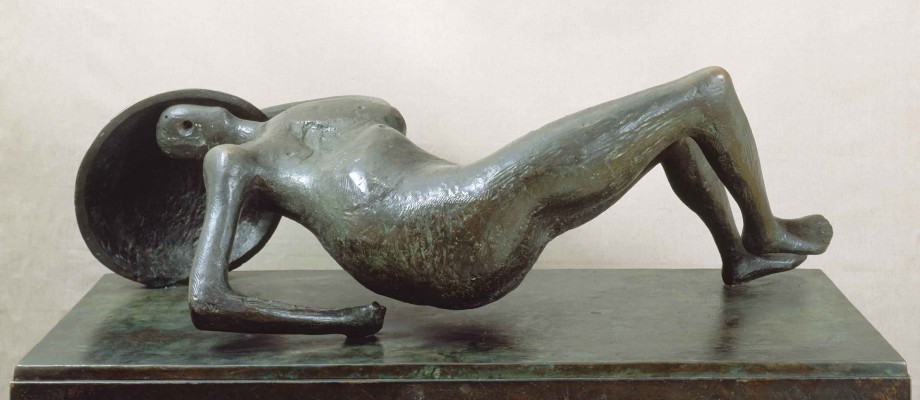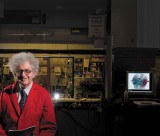
The art of war at Lakeside
March 2nd, 2015
As the 70th anniversary of the end of the Second World War approaches, two exhibitions at Nottingham Lakeside Arts bring together artists whose creativity and experiences were shaped by the conflict and its aftermath.
Lee Miller’s War focuses on one of the least recognised episodes in the iconic model and photographer’s remarkable life. In 1944, while working as a freelance photographer for Vogue, Miller became the only female combat photojournalist in Europe.
The exhibition includes 40 photographs from the Lee Miller Archive. Her photographs of the liberation of Paris and the Buchenwald and Dachau concentration camps serve not only as historical records but are also as powerful images in their own right that sear into the memory. Described by a fellow photographer as “never afraid of what the evil men do”, it was this that allowed her to keep on photographing, despite witnessing some of mankind’s worst acts of inhumanity.
The second exhibition, In the Shadow of War, is showing alongside Miller’s photographs and features a generation of artists who rose to prominence in post-war Britain. The 40s-50s was a period of recovery and reconstruction, marked by austerity and the newly drawn battlelines of Cold War politics. In the arts, as in life, the shadow of the war loomed large until well into the 1950s; the paintings and sculptures in this exhibition contain numerous references to the trauma of the conflict.
Francis Bacon’s anguished subject matter contained veiled references to Nazi propaganda while Graham Sutherland made direct use of photographs of the victims of concentration camps to portray his tortured figure of Christ on the cross.
Throughout the 50s, the Jewish émigré Frank Auerbach and his friend Leon Kossoff dedicated themselves to a series of paintings of London’s building sites, many of which had been caused by bombing raids during the Blitz. Merlyn Evans made direct references to his own wartime experiences in the painting The Execution.
A spirit of despair described as the ‘geometry of fear’ was seen to be the hallmark of a group of young sculptors including Lynn Chadwick, Bernard Meadows and Reg Butler. Elisabeth Frink’s childhood experiences of living close to an airfield during the war influenced a series of bronze warrior birds made in the 1950s that are an explicit statement of aggression.
Head of Visual Arts Programming at Lakeside, Neil Walker, who curated the exhibition said: “The late 40s and 50s was an incredibly fertile period in British art but the work of figurative artists has tended since to be overshadowed by American-influenced abstract painting and the birth of pop art. This exhibition brings together many of the names who were to seen at the time to be at the vanguard of modern art in this country.”
Other artists in the exhibition include: John Bratby, Prunella Clough, Robert Colquhoun, Derrick Greaves, Lucian Freud, Josef Herman, Patrick Heron, LS Lowry, Robert MacBryde, Edward Middleditch, John Minton, Eduardo Paolozzi, Ceri Richards, Jack Smith, William Turnbull, Keith Vaughan.
In the Shadow of War and Lee Miller’s War continue at Djanogly Art Gallery, Nottingham Lakeside Arts, until Sunday 22 February. For more information and opening times, visit www.lakesidearts.org.uk
Tags: Ceri Richards, Derrick Greaves, Eduardo Paolozzi, Edward Middleditch, Elisabeth Frink, Francis Bacon, Frank Auerbach, Graham Sutherland, In the Shadow of War, Jack Smith, John Bratby, John Minton, Josef Herman, Keith Vaughan, Lee Miller’s War, Leon Kossoff, LS Lowry, Lucian Freud, Merlyn Evans, Neil Walker, Nottingham Lakeside Arts, Patrick Heron, Prunella Clough, Robert Colquhoun, Robert MacBryde, William Turnbull
Comments are closed.
Other Issue 81

Cornea team researchers of the year
Nottingham picked up Research Project of the Year at the Times Higher Education Awards 2014. Scientists […]

Professor Martyn Poliakoff knighted
Professor Martyn Poliakoff was knighted in the Queen’s New Year Honours 2015. Professor Poliakoff received the […]

